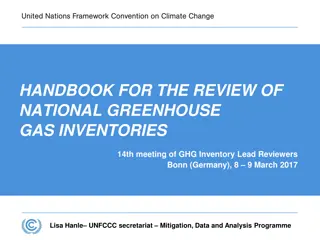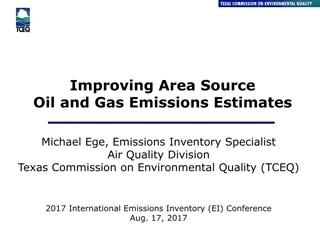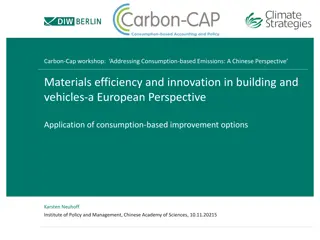Understanding Consumption-Based Emissions Inventories in Boulder County
Consumption-Based Emissions Inventories (CBEIs) play a crucial role in assessing greenhouse gas emissions linked to local consumption patterns. By calculating emissions associated with products and services used by a community, CBEIs reveal significant gaps in traditional emissions tracking, emphasizing the need for more comprehensive data to guide effective climate mitigation strategies. The overview of Boulder County's 2021 CBEI highlights key findings and implications for sustainable practices.
Download Presentation

Please find below an Image/Link to download the presentation.
The content on the website is provided AS IS for your information and personal use only. It may not be sold, licensed, or shared on other websites without obtaining consent from the author. Download presentation by click this link. If you encounter any issues during the download, it is possible that the publisher has removed the file from their server.
E N D
Presentation Transcript
Boulder County Consumption-Based Emissions Inventory By Tim Broderick: Senior Sustainability Strategist, OSCAR
What is a Consumption-Based Emissions Inventory? A consumption-based emissions inventory (CBEI) calculates the greenhouse gas (GHG) emissions associated with producing, transporting, using, and disposing of products and services consumed by a particular community in a given year. (USDN Sustainable Consumption Toolkit) Source: C40 Cities
Why CBEIs Matter There are only a handful of Consumption-based Inventories. Their results, however, are striking because they highlight the large percentage of GHGs that are not being measured and tracked. Given the oft-quoted maxim, what gets measured gets managed, the failure to track GHGs associated with the local consumption of goods, food, and services has dire implications for what is measured and managed. Failure to measure consumption-based GHGs provides incomplete data to local governments and citizens. Without the complete data, meaningful and targeted climate mitigation regulation is extraordinarily difficult. - Jonathan Rosenbloom, University of Colorado Law Review; Outsourced Emissions: Why Local Governments Should Track and Measure Consumption- Based Greenhouse Gases March 18, 2021
Consumption-Based Emissions Inventory Overview 5 household consumption categories: Transportation, housing, food, goods, & services of residents Driven by 6 key characteristics: o Income o Household size o Home size (# rooms) Home ownership Vehicle ownership Educational attainment o o o Average household characteristics Includes incorporated + unincorporated communities
Consumption-Based Inventory 2021 CBEI: 45 MTCO2e per HH 19 MTCO2e per person 6 million MTCO2e countywide Consumption-based approach: +43% 2021 GHG Inventory: 13 MTCO2e per person 4.2 million MTCO2e countywide
CBEI: Key Takeaways High energy emissions have declined significantly due to cleaner power, but still a long ways to go. Highly auto-dependent, large home sizes Transportation & buildings largest categories aligned with geographic inventory. Food & Services are almost as large as residential energy usage Mostly minor changes in household characteristics since 2007
Transportation Collaboration with existing efforts Deepen regional goals between electrification of transportation, reduction in vehicle ownership, building densification, affordable housing, and public health impacts. Consider support for the development of sustainable aviation fuel production locally within the county (?)
Housing Support existing electrification programs Building ordinances that require the use of recyclable, recycled content, or carbon reduced building materials. Ordinances need to align with county or regional inputs such as recycled concrete. Lean on existing efforts to densify and create smaller living footprints along public transportation pathways. Deconstruction ordinances to divert materials from the landfill and decrease incoming building materials supply chains. C&D sortation infrastructure to support a more closed loop supply chain for building materials.
Food Elimination of the use of synthetic fertilizers on all public lands and private. This means alternatives such as compost and livestock nitrogen must be supported as supply chain alternatives. Red meat tax, has impacts on both climate and public health. Tax would go directly towards supporting regenerative agriculture. Systems level change is build into the pricing structure the negative externalities of goods consumed. Food waste diversion policy, tier 1 edible foot waste to food banks. Tier 2 compost which would increase availability of high quality compost and ties with the recent change of A1 organics policy of food waste only diversion.
Goods EPR extension to all categories of consumed goods starting with furniture and household appliances (durable goods). Systems level change is build into the pricing structure the negative externalities of goods consumed. Support building code and land use development to support dense / small footprint housing. Develop a program to work with existing manufacturers (10% of the states manufacturing) to decrease scope 3 emissions.
Services Accelerate the work of green businuess programs across the county with data sets on industry specific consumption impacts. Collaborate with existing programs to engage healthcare services specifically to decrease their carbon footprint. Systems level change is build into the pricing structure the negative externalities of services consumed.























